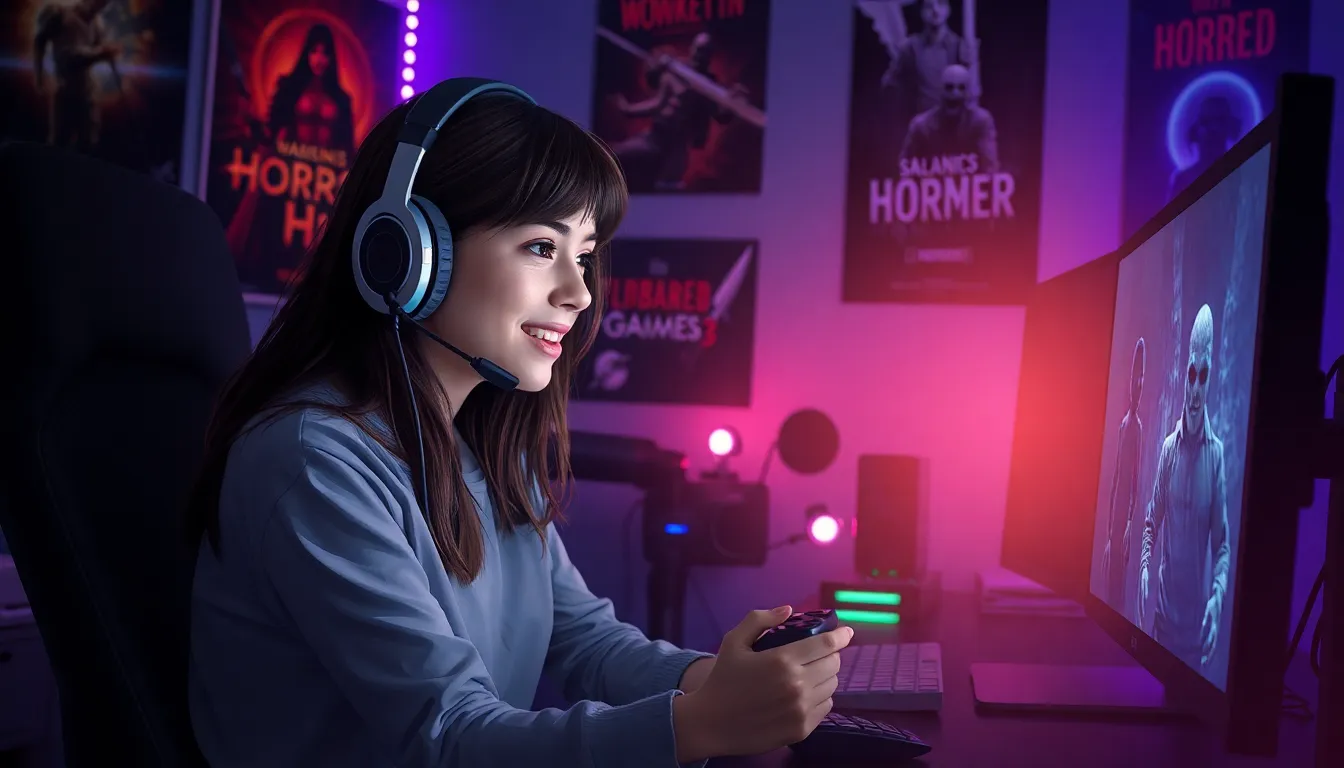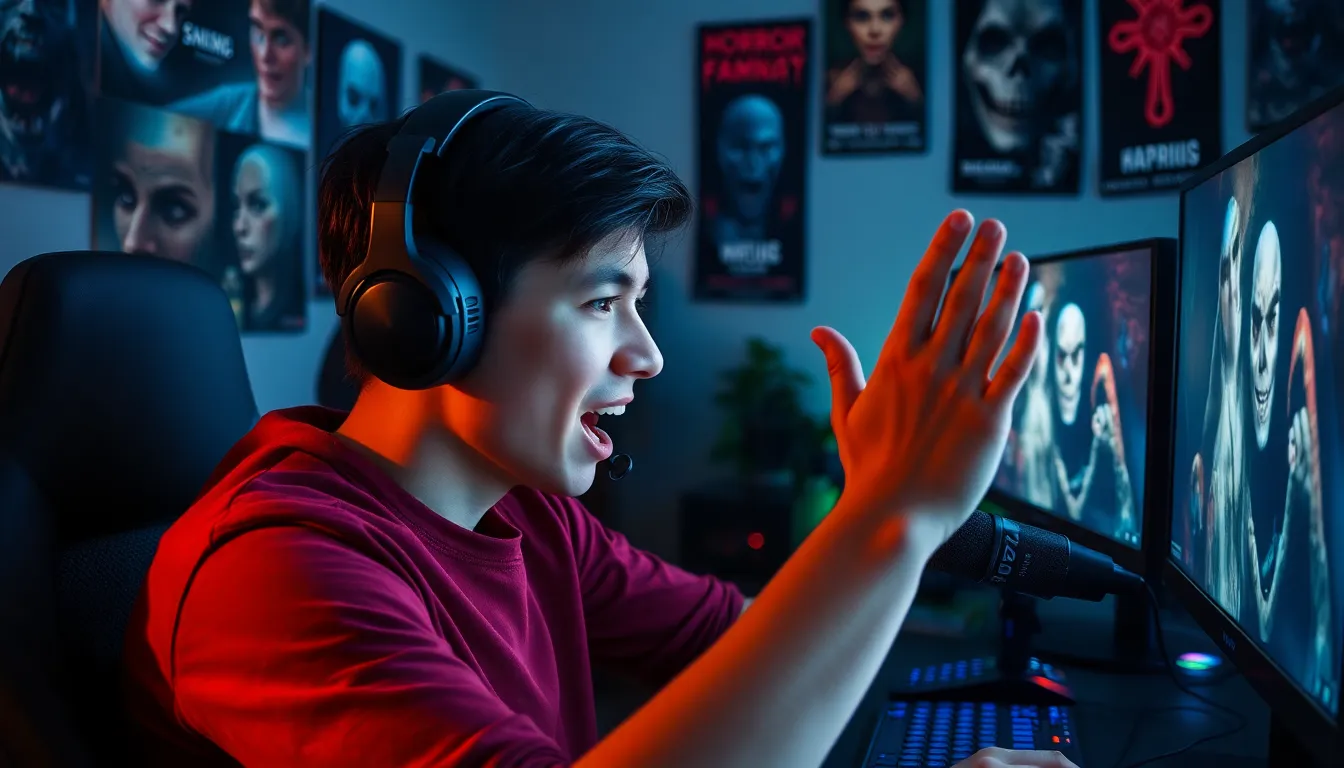In a world where jump scares reign supreme and creepy soundtracks send shivers down spines, horror game streaming has emerged as the ultimate thrill ride for gamers and viewers alike. Picture this: you’re nestled on your couch, popcorn in hand, while your favorite streamer battles terrifying monsters, all while trying not to scream louder than you. It’s the perfect blend of entertainment and adrenaline, where every scream and laugh creates a shared experience that’s hard to resist.
As horror games evolve, so does the community around them. Streamers are no longer just players; they’re storytellers, guiding their audience through dark narratives and heart-pounding moments. Whether it’s a ghostly whisper or a sudden jump scare, the excitement is palpable. So grab your headset and get ready to dive into the chilling world of horror game streaming—where every stream is a chance to confront fears and share a laugh, all from the safety of your living room.
Table of Contents
ToggleOverview Of Horror Game Streaming
Horror game streaming captivates audiences with its unique blend of fear and entertainment. Viewers find themselves drawn to streamers who adeptly navigate terrifying scenarios. Engaging gameplay coupled with a charismatic presence keeps audiences on the edge of their seats. Streamers often act as storytellers, transforming gaming into a thrilling narrative experience.
High-quality production elements heighten the horror theme, including live commentary and visual effects. Many streamers utilize overlays and special alerts to enhance viewer interaction. This interactive experience fosters a sense of community, as audiences can react in real-time to in-game events.
Statistics indicate that horror games rank among the most-watched genres on streaming platforms. In 2022, horror games garnered over 1.5 billion total views on Twitch alone. Popular titles like “Resident Evil” and “Amnesia” frequently attract substantial viewership, allowing streamers to build dedicated followings.
The fear factor also plays a significant role in viewer engagement. Spectators often experience shared adrenaline while watching streamers confront jump scares and monstrous foes. Social media platforms amplify this effect by allowing viewers to discuss memorable moments and share clips.
As technology advances, the appeal of horror game streaming continues to grow. Virtual reality elements and immersive sound design add new dimensions to the horror gaming experience. Streamers adapting to these innovations capture the attention of both newcomers and seasoned fans. Ultimately, horror game streaming remains an evolving phenomenon that combines entertainment, community, and storytelling.
Popular Platforms For Streaming

Several platforms dominate the horror game streaming scene, providing gamers and viewers with thrilling content. These platforms create unique environments that amplify the excitement and engagement of horror gaming.
Twitch
Twitch stands out as a leading platform for streaming horror games. Its emphasis on live interactions enables streamers to engage directly with viewers, creating an immersive experience. In 2022, horror games attracted over 1.5 billion views, showcasing their popularity. Popular streamers often cultivate dedicated communities, enhancing the shared thrill of jump scares. Features like chat rooms allow real-time audience reactions, fostering a sense of camaraderie. With a variety of streaming tools and extensions, Twitch empowers content creators to personalize their channels effectively.
YouTube Gaming
YouTube Gaming ranks highly as another prominent platform for horror game streaming. It enables gamers to share recorded content with extensive reach, drawing in large numbers of viewers. The ability to create edited highlights makes it easy for audiences to revisit memorable moments. Differentiating itself, YouTube Gaming offers integration with Google tools, enhancing discoverability. Popular horror titles like “Resident Evil” and “Amnesia” consistently attract substantial traffic, highlighting viewer interest. Streamers can leverage YouTube’s features to build significant followings and cultivate engaging channels.
Key Elements Of Engaging Horror Game Streams
Engaging horror game streams depend on various elements that elevate the viewer experience. Key aspects include interactive audience engagement and effective atmosphere creation.
Interactive Audience Engagement
Streamers captivate their audience through direct interaction. Utilizing chat features, they respond to viewer comments in real-time, fostering a sense of involvement. Streamers often involve their audience in decision-making processes, heightening suspense. Engaging polls or viewer challenges enhance replayability by inviting participation. Incorporating challenges or reactions from viewers can amplify adrenaline-fueled moments, solidifying community bonds. Specific horror games like “Phasmophobia” thrive on viewer input, enhancing the interactive experience. Such engagement fosters a shared sense of discovery and excitement.
Building Atmosphere And Suspense
Atmosphere plays a crucial role in horror game streaming, creating intense experiences. Effective use of sound effects heightens tension, while dramatic visuals draw viewers into the gameplay. Carefully edited highlights or live commentary guide the audience through thrilling narratives, amplifying suspense. Streamers frequently employ pacing techniques, pausing during high-stakes moments to build anticipation. Creating unique soundscapes enriches storytelling, while darkness and lighting evoke feelings of unease. Memorable jump scares become more impactful with suspenseful setups, ensuring viewers remain on the edge of their seats. These elements collectively transform streaming into immersive experiences that resonate with audiences.
Notable Horror Game Titles
Horror games captivate audiences, with notable titles leading the charge. Each game brings unique elements that enhance the streaming experience.
Resident Evil Series
The Resident Evil series ranks among the most influential horror franchises in gaming. Each installment features a mix of survival horror and engaging narratives. Players uncover dark secrets while battling mutated creatures and solving puzzles. Streamers often highlight their favorite moments, showcasing intense confrontations and clever problem-solving. Viewers enjoy the suspenseful atmosphere created by sound design and graphics. Classics like Resident Evil 2 and recent entries like Resident Evil Village receive significant attention on streaming platforms. This popularity translates into a large audience for streamers dedicated to the series.
Outlast Series
The Outlast series offers a different approach to horror gaming. With first-person perspectives and immersive storytelling, players experience relentless terror in a variety of unsettling environments. The gameplay revolves around evading enemies rather than combat, elevating the tension. Streamers commonly share their heart-pounding encounters, drawing viewers into the adrenaline-fueled gameplay. The dark, atmospheric visuals and sound create a gripping experience that captivates audiences. As streamers navigate each level, they forge connections with viewers through shared fear and excitement. Outlast has become a staple in horror game streaming, attracting significant viewership across platforms.
The Impact Of Horror Game Streaming On Community
Horror game streaming fosters a unique sense of community among viewers and streamers. Engagement during live broadcasts prompts vibrant interactions, inviting audiences to share their reactions in real-time. Streamers cultivate camaraderie with their followers, often referring to them as part of their family.
Shared experiences during chilling gameplay sessions enhance the communal aspect. Viewers cheer for streamers confronting terrifying foes, amplifying the adrenaline rush and deepening connections. For example, games like “Phasmophobia” leverage audience participation, allowing viewers to influence decisions, fostering a collective sense of adventure.
Platforms like Twitch emphasize chat interactions, where communities can discuss strategies and share fears. Streamers often respond to comments, creating a conversational atmosphere that encourages participation. This dynamic leads to loyal followers who return for the thrill of shared experiences.
Data shows that horror game streaming reaches over 1.5 billion views on Twitch, underscoring its popularity. Engaging with horror gaming content builds a vibrant community that thrives on collective excitement. The immediacy of reactions transforms viewers into active participants rather than passive spectators.
In addition, social media plays a pivotal role in enhancing the community. Memorable moments shared on platforms like Twitter spark conversations, fueling further interest in both the games and the streamers. Discussing scares and strategies helps communities bond over mutual interests.
Horror game streaming’s influence transcends entertainment, establishing spaces for connection and community-building. Viewers who come for the fear often stay for the shared experiences, allowing horror gaming to evolve into a collaborative journey. This phenomenon not only enriches the audience’s connection to the game but also enhances the streamer’s experience, creating a robust culture around horror gaming.
Horror game streaming has carved out a unique niche in the gaming world. It combines adrenaline-pumping gameplay with community engagement that keeps viewers coming back for more. Streamers have transformed into captivating storytellers who draw audiences into their thrilling narratives.
The immersive experiences offered by platforms like Twitch and YouTube Gaming enhance the excitement and foster a sense of belonging among fans. As technology continues to evolve, horror game streaming is set to grow even more, offering fresh ways for audiences to connect with their favorite games and streamers. This genre’s blend of fear, entertainment, and community makes it a powerful force in the streaming landscape.

